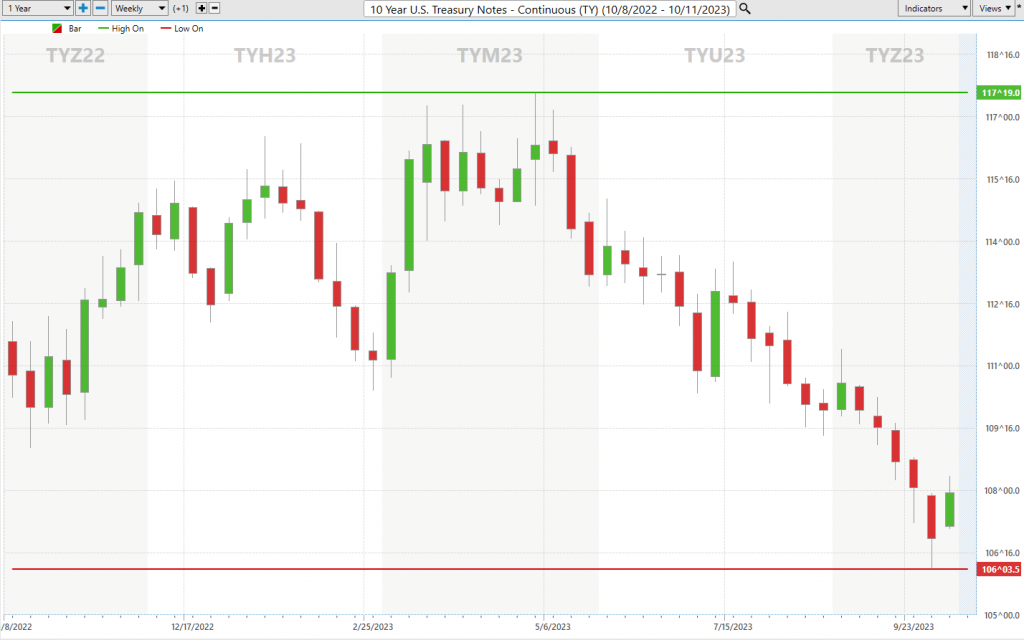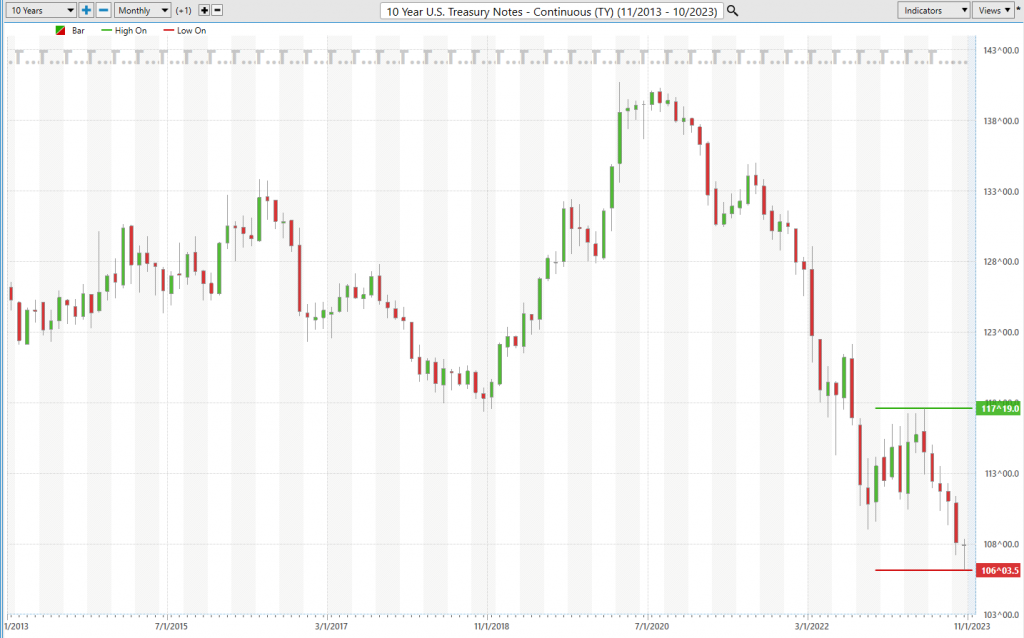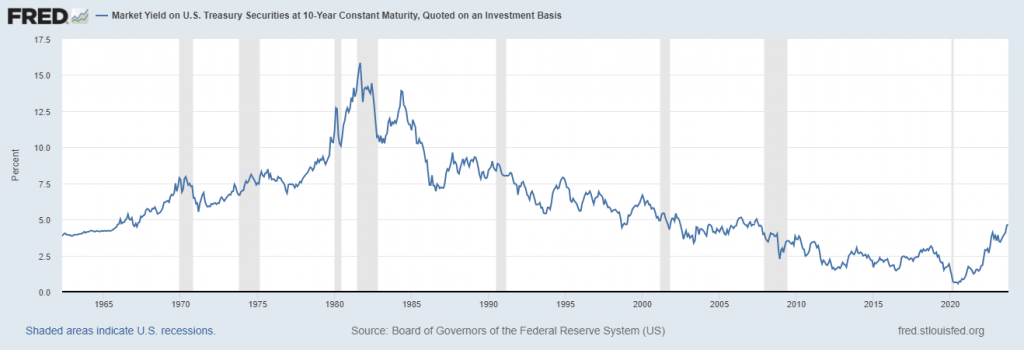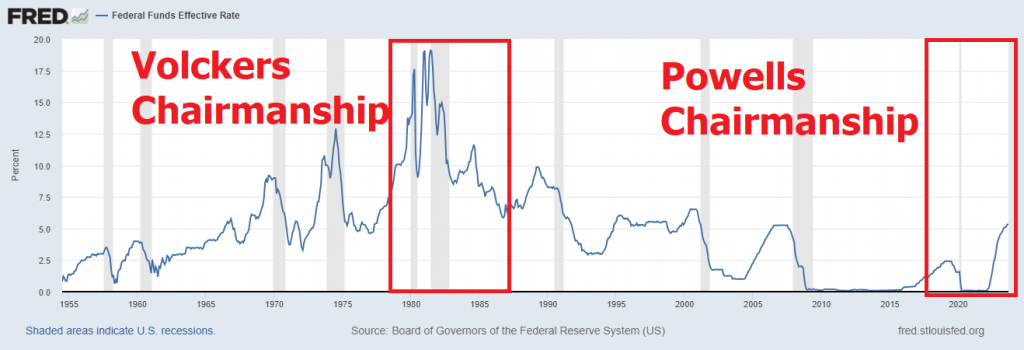We’ve witnessed nothing short of a seismic upheaval in the world of finance since that fateful month in March 2020. I’m talking about a cataclysmic 46% nosedive in Treasury bonds sporting maturities of a decade or more, as reported by the venerable Bloomberg. The 30-year Treasury has lost 53% of its value! Now, for generations, the Treasury market has held a special place in the hearts of conservative investors, often referred to as “widows, orphans, and retirees.” These individuals have traditionally turned to Treasury bonds and notes as a reliable means to generate a steady and predictable stream of income. The purpose of a Treasury Bond or Note is, at its core, to provide a secure and low-risk investment vehicle for both individuals and institutions. When you invest in a Treasury security, you are essentially lending money to the U.S. government, which, as one of the world’s most creditworthy borrowers, offers a virtually guaranteed return on your investment. This stability and income security have made Treasury securities a staple for those who prioritize safety and income generation over speculative gains.
Now, let’s talk about the typical investors in Treasuries. They hail from diverse backgrounds. Individual investors seeking a safe haven for their savings, retirees looking for a stable income source, and institutional investors like pension funds and insurance companies, who require low-risk assets to meet their long-term obligations, are the primary participants in this market. Treasury securities also serve as a benchmark for financial institutions when pricing other products like mortgages and corporate bonds. However, there’s an elephant in the room. The risk looms large when interest rates take an exponential leap. When those long-term yields on Treasury bonds start rising significantly, the market value of existing bonds takes a nosedive. This means that investors who hold these bonds could see the value of their investments plummet. For retirees and those relying on fixed income, this can be particularly concerning, as it erodes the purchasing power of their savings. Moreover, soaring interest rates can increase borrowing costs for businesses and individuals, potentially putting the brakes on economic activity and influencing investment decisions, which can have far-reaching implications for the broader economy. So, while Treasury securities are known for their safety, they aren’t entirely immune to market dynamics and the impact of interest rate fluctuations that can shake investors and the broader financial landscape to the core. What is most alarming though is the 46% nosedive in value that has occurred in Treasuries’ value and how this has adversely affected widows, orphans, and retirees.
I have written about this problem for the last several years on this blog. Treasuries are toxic assets. They’re responsible for the recent banking crisis. Traders and investors seeking safe havens are moving to the short end of the Treasury curve when no other option exists.
You can read previous articles on this theme here.
Are We Witnessing the Beginning of a Sovereign Debt Crisis Internationally?
De-Dollarization, Sovereign Debt and Why It Matters!
Where Are The Safe Havens? Risk, De-Dollarization and The Bond Rating Agencies
What we’re seeing is almost mirroring the catastrophic losses witnessed during the dot-com bubble burst, when our stock markets were sent reeling. Yet, there’s more to this story. This bond rout is on a scale grander than the harrowing events of 1981 when the ominous specter of a 16% yield on the 10-year Treasury bond sent shivers down the spine of the financial world. Make no mistake, this bond-market sell-off, which is catapulting yields to stratospheric heights, is overshadowing some of the most colossal market meltdowns ever. What’s most disturbing is that it’s happening in the TREASURY market, which has long been considered the premiere risk-free vehicle for generating income.
What I’m about to tell you might just send shockwaves through your understanding of the financial world. You see, 2022, my friends, it was an absolute disaster for US Treasuries, and I’m not mincing words here—it was the WORST year for US Treasuries in all of American history.
Just take a moment to let that sink in. The benchmark 10-year Treasury, a cornerstone of the financial universe, took an 18% tumble, while the venerable 30-year Treasury, well, practically fell off a cliff, collapsing by a staggering 39%. And hold onto your hats, folks, because many other bonds fared even worse.
Now, I know what some of you might be thinking. “But aren’t Treasuries supposed to be as safe as apple pie and grandma’s hugs?” Well, that’s what they’ve been telling us for ages, isn’t it? The idea that Treasuries are “risk-free” has been drilled into our heads. But let me tell you, my friends, 2022 has shattered that illusion into a million pieces.
If you look at the 52-week chart and the 10-year chart you can quickly see that investors and traders are favoring the short side of the Treasury market.


You see, bonds, and in particular, those sacred Treasuries, were the go-to savings account for savers and investors all around the globe. The financial masses parked their hard-earned money there because they were led to believe it was the prudent thing to do. Fast forward to today, and the global bond market, it’s a behemoth worth more than an astounding $133 trillion. To put it in perspective, all the gold ever mined in the world, well, it’s worth a paltry $12.7 trillion, less than a tenth of the bond market’s colossal value.
But hold on tight because the worst, my friends, is not behind us. The pain for bondholders, it’s just getting started. Bonds, once considered a safe haven, are now turning into a graveyard for your hard-earned capital. The days of relying on them as a reliable store of value asset are swiftly fading. I’m not talking gloom and doom; I’m talking simple math.
Let me explain.

The Consumer Price Index came in this morning at a 3.6% annualized increase. On a monthly basis, CPI increased by .4% over the previous month. From just this information you can quickly understand why Treasuries are in trouble.
The current yield on the 10-year T-Note is 4.6%. So, if we believe the government’s numbers, we can subtract inflation from the current yield and that will be our real rate of return. The best-case scenario is that if you invest in Treasuries at the current level, and inflation remains stable you will generate a 1% annualized return! Meanwhile, you have to stomach the unfortunate reality that since March 2020 your Bonds have lost 46%!
But here is what is really scary. The debt crisis is looming large. Government bonds, they’re puffing up like a balloon ready to burst.
Picture this: in the next three years, the big four central banks – the heavyweight champs, US, EU, Japan, and China – they gotta scrape together a whopping $34 TRILLION bucks.
But here’s the kicker, folks: Who’s gonna step up to the plate and buy all that massive debt?
I’ll tell ya straight, my friend – it’s gonna be a ghost town out there. Nobody’s gonna touch that $34 TRILLION debt pile with a ten-foot pole. That spells massive volatility and opportunity.
Then to add insult to injury the government has to fund its operations and this year they have already generated a two trillion-dollar deficit. That is a whole lot more Treasuries that need to be created out of thin air to fund the government.
Nobody will say what I am about to say.
Bonds are on a one-way ticket to value oblivion. Investors, they’re going to run away from them like a bat out of hell.
Now, you might be wondering, if not bonds, then where will people, companies, and nations stash their cash? Well, my friends, a seismic shift is underway. The $133 trillion in the global bond market is going to move elsewhere, either voluntarily, seeking superior store-of-value assets, or involuntarily, as bankrupt governments orchestrate the largest wealth transfer in the annals of history.
This is the Big Picture that many still fail to grasp.
Folks let’s get real here because it’s high time someone said it plain and clear! When you’ve got trouble brewing in the BOND markets, you can kiss those safe havens goodbye. Picture this: you’re at the casino, and they’re pushing you to play before your chips turn to dust. That’s the reality we’re facing, and I’m not here to sugarcoat it. Show me a strong, healthy company or country that’s got a shaky bond market, and I’ll eat my hat!
Now, let’s rewind the tape to the early part of 2023, where we witnessed a seismic shift in the global economy. It was like nothing we’d seen before. The U.S. dollar, the big dog in the world of reserve currencies, was under siege. Who was leading the charge against the dollar’s dominance? None other than the BRICS nations – Brazil, Russia, India, China, South Africa – and let’s not forget about Saudi Arabia, folks! These economic heavyweights had a bone to pick with the dollar, and they weren’t holding back. They wanted more financial stability and clout, and they were determined to get it. So, when the opportunity came knocking to join forces and challenge the dollar’s supremacy, they grabbed it with both hands. Now, don’t get me wrong, the good old’ U.S. of A’s economic prowess wasn’t exactly on the ropes, but this move sent shockwaves through the financial world. Investors started looking elsewhere, exploring new currencies and securities from other countries. And let me tell you, those ripples are still causing waves today, even though things have settled down a bit.
You see, bonds enjoyed a more than 40-year bull market run. It’s no surprise that complacency runs deep. But here’s the kicker, the foundation of the global bond market, it’s crumbling. The post-WWII era, where Treasuries were the bedrock of the financial world, that’s fading away. The supply of Treasuries is surging, and the pool of eager buyers, well, is drying up faster than a desert oasis.
But here’s the cold, hard truth. The US government is sitting on the largest debt pile in human history, a whopping $33 TRILLION! Wrap your head around that number for a moment. If you earned a dollar every second, 24/7, it would take over 1,029,860 YEARS to pay off that debt. And that’s assuming it stops growing, which, let’s face it, it won’t.
So, here’s the real question: It’s not whether the US government will default, it’s how they’ll do it. When push comes to shove, politicians always choose the easy way out, which means issuing more debt rather than making those tough budget calls.
Let’s talk about interest rates. The US government can’t afford to let them rise too high, not with this mountain of debt. But higher rates are the only way to attract new buyers. So, who’s left to finance these trillion-dollar deficits? It’s none other than the Federal Reserve, the ultimate buyer with pockets deep enough to create money out of thin air.
But that is a recipe for currency debasement, a value-vanishing act that’ll hit your wallet where it hurts the most.
So, to sum it up, the US government can’t pay off its debt, they won’t outright default, they can’t entice enough buyers with higher rates, and the only entity left to the rescue is the Fed, bringing currency debasement in its wake.
History is littered with those who failed to see the big picture and take the right steps during times of profound change. Educate yourselves, stay informed, and prepare for the storm that’s brewing on the horizon.
When we peer back into the bowels of bond-market history, we’re looking at one of the most colossal unraveling’s of all time for long-term Treasurys. These losses are more than twice the magnitude of the carnage seen in 1981 when the 10-year yields threatened to breach that eye-watering 16% mark.

Now, rewind the tape a bit. Think back to 1981 when the indomitable Paul Volcker grappled with raging inflation, steering the federal funds rate perilously close to that 20% threshold. Times have changed, my friends, and interest rates today remain considerably lower. But what we’re witnessing is a bond-market upheaval reminiscent of those bygone days. And more importantly, the nation has a $33 trillion government debt of which more than 50% of it will need to be refinanced in the next 5 years.
That’s a lot of bonds hitting the market simultaneously and yields will have to be significantly higher to attract long term investors particularly after the bloodbath they have experienced since March 2020.
Traders are hitting the panic button, unleashing a relentless wave of selling. Their fear? A resurgent inflation monster on the horizon. But that’s not all, folks. A tidal wave of Treasury issuance this year has piled even more pressure on bond prices.
Long-duration yields, as a result, have skyrocketed to levels not seen since 2007. And when we talk about the venerable 30-year note breaching that 5% barrier for the first time in eons, it’s like discovering a financial fossil. Investors are bracing for the 10-year to follow suit, lurking just above that 4.7% precipice.
Amidst the turmoil in the US bond market, a critical juncture emerges. Investors must now cast their gaze upon the evolving landscape of US bond yields. The prevailing situation presents a disconcerting phenomenon, wherein confidence in the world’s reserve currency and our sovereign debt is visibly fissuring, eroding, and deteriorating before our very eyes.
Prominent figures in the financial world, including the likes of Bill Ackman, Ray Dalio, and Bill Gross, are sounding the alarm, predicting that the 10-year’s relentless ascent will soon breach the 5% threshold.
In my opinion, the financial rollercoaster ride is far from over, and we’re navigating uncharted waters. Let’s dive straight into the heart of the matter, because it’s high time someone laid it all out on the table, no sugarcoating. When we talk about trouble brewing in the BOND markets, that’s when you know we’re in deep waters. It’s like being at the casino, and they’re pushing you to lay your bets before those chips of yours lose their value faster than a snowflake in July. I know it sounds harsh, maybe even grim, but here’s the deal: Show me a robust, thriving company or a nation that’s got a shaky bond market, and I’ll eat my hat.
Now, let’s rewind to the early part of 2023, a year that saw the global economic landscape undergo a transformation like never before. We’re talking about a shift away from the U.S. dollar, the world’s go-to reserve currency. Who was leading this charge? The BRICS nations, folks – Brazil, Russia, India, China, South Africa – and don’t forget Saudi Arabia, they were right there in the mix! These economic titans had been eyeing a boost in their financial stature and stability for quite some time. So, when the opportunity presented itself to team up and challenge the dollar’s dominance in the international arena, they seized it with both hands. Now, mind you, the U.S.’s economic strength wasn’t crumbling to the ground, but this move sent shockwaves across the financial globe. Investors started hunting for fresh opportunities in other currencies and securities, and let me tell you, those ripples are still echoing today, even as things have settled down a bit.
Now, let’s shift gears and talk about what’s been keeping traders and investors up at night in 2023. It’s a laundry list of worries, and here’s the lowdown:
1. Attacks on Energy Infrastructure
2. Bond yields spiraling higher than anticipated
3. Contagion from High-Yield Defaults
4. Lingering Inflationary Pressure on Food
5. Cryptocurrency Turmoil
6. Cybersecurity Risks and Cyber Attacks
7. Escalation in the Russia-Ukraine Conflict
8. A Looming Food Crisis
9. Global Regional Housing Market Tumult
10. Higher-than-Expected Inflation
11. Escalating Cost of Living
12. Liquidity Crisis in Private Capital Markets
13. Natural Disasters
14. Fresh Energy Price Shockers
15. A Potential Severe Recession
16. A Sovereign Debt Crisis
17. The Threat of Stagflation
18. The Tech Bubble’s Slow Burst
19. U.S.-China Trade War Heating Up
20. U.S. Debt Ceiling Drama
Amidst all this chaos and uncertainty, there’s one thing that matters above all else for traders, and that’s PRICE. Opinions, they’re just tales we tell ourselves, but the TREND, that’s where the FACTS lie. The trend, it’s the compass that guides us through the uncharted waters of the markets.
You see, traditional economic theories, they don’t cut it for us traders. What we care about, day in and day out, is being on the right side of the right market at the right time. And how do we navigate this ever-changing landscape? We harness the incredible power of VantagePoint’s artificial intelligence, that’s how. Everything else is just noise, distractions in the grand symphony of market movements.
The race to debase is real. In this economic environment, we’re all trading with an eagle eye on shorter time frames, chasing yield like it’s the pot of gold at the end of the rainbow. Do you have the tools, the know-how to spot those powerhouse trends at the right moment in this economic whirlwind? What’s your game plan for safeguarding your purchasing power as this trend goes into overdrive?
Artificial intelligence, it’s a game-changer because it learns from its mistakes, remembers them, and keeps forging new paths to find solutions. That’s the feedback loop that’s built fortunes for every successful trader I know. It’s a simple yet powerful concept, and here’s the kicker: A.I. applies mistake prevention round the clock, every day of the year, toward solving the problem at hand.
And that is the secret sauce that’s changing the game. It may sound elementary, but let me tell you, overlooking the basics can sting your portfolio. Neural networks, artificial intelligence, machine learning – they’re all about pattern recognition, identifying the best path forward. So, when these technologies flash a new forecast, it’s headline-worthy. We may not always grasp why something’s happening, but that doesn’t mean we can’t capitalize on it.
A.I., with its advanced pattern recognition, crunching mountains of data, it spots the highest probability trades – and that’s invaluable. We may not always understand the “why” behind market movements, but we can sure as heck ride the wave. So, keep your eyes on what IS happening, not what SHOULD happen, because in these uncharted waters, PRICE is king, and artificial intelligence is your guiding light.
What all traders and investors want is an accurate, proven solution that alerts you when a high probability trend is unfolding. The Vantagepoint A.I. forecasts have proven to be up to 87.4% accurate in determining the trend three days in advance.
Visit with us and check out the A.I. at our Next Live Training.
It’s not magic. It’s machine learning.
Make it count.
THERE IS A SUBSTANTIAL RISK OF LOSS ASSOCIATED WITH TRADING. ONLY RISK CAPITAL SHOULD BE USED TO TRADE. TRADING STOCKS, FUTURES, OPTIONS, FOREX, AND ETFs IS NOT SUITABLE FOR EVERYONE.IMPORTANT NOTICE!
DISCLAIMER: STOCKS, FUTURES, OPTIONS, ETFs AND CURRENCY TRADING ALL HAVE LARGE POTENTIAL REWARDS, BUT THEY ALSO HAVE LARGE POTENTIAL RISK. YOU MUST BE AWARE OF THE RISKS AND BE WILLING TO ACCEPT THEM IN ORDER TO INVEST IN THESE MARKETS. DON’T TRADE WITH MONEY YOU CAN’T AFFORD TO LOSE. THIS ARTICLE AND WEBSITE IS NEITHER A SOLICITATION NOR AN OFFER TO BUY/SELL FUTURES, OPTIONS, STOCKS, OR CURRENCIES. NO REPRESENTATION IS BEING MADE THAT ANY ACCOUNT WILL OR IS LIKELY TO ACHIEVE PROFITS OR LOSSES SIMILAR TO THOSE DISCUSSED ON THIS ARTICLE OR WEBSITE. THE PAST PERFORMANCE OF ANY TRADING SYSTEM OR METHODOLOGY IS NOT NECESSARILY INDICATIVE OF FUTURE RESULTS. CFTC RULE 4.41 – HYPOTHETICAL OR SIMULATED PERFORMANCE RESULTS HAVE CERTAIN LIMITATIONS. UNLIKE AN ACTUAL PERFORMANCE RECORD, SIMULATED RESULTS DO NOT REPRESENT ACTUAL TRADING. ALSO, SINCE THE TRADES HAVE NOT BEEN EXECUTED, THE RESULTS MAY HAVE UNDER-OR-OVER COMPENSATED FOR THE IMPACT, IF ANY, OF CERTAIN MARKET FACTORS, SUCH AS LACK OF LIQUIDITY. SIMULATED TRADING PROGRAMS IN GENERAL ARE ALSO SUBJECT TO THE FACT THAT THEY ARE DESIGNED WITH THE BENEFIT OF HINDSIGHT. NO REPRESENTATION IS BEING MADE THAT ANY ACCOUNT WILL OR IS LIKELY TO ACHIEVE PROFIT OR LOSSES SIMILAR TO THOSE SHOWN.






